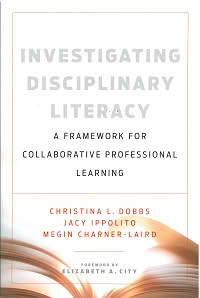Principal’s Bookshelf: Reading Across the Curriculum
Book outlines a step-by-step approach to disciplinary literacy.
Book outlines a step-by-step approach to disciplinary literacy.
By Brian Bond
Principal, January/February 2018. Volume 97, Number 3.
 You have probably heard the phrase “moving out of their comfort zone.” Well, for me, exploring Investigating Disciplinary Literacy (Harvard Education Press, 2017) was a move outside my comfort zone. As an elementary school principal, much of my time with planning reading instruction is spent on the ins and outs of teaching children how to read. Phonemic awareness, fluency checks, letter sounds, and such are second nature in the world of elementary literacy. This book moved beyond these beginning skills to the world of middle and high school literacy.
You have probably heard the phrase “moving out of their comfort zone.” Well, for me, exploring Investigating Disciplinary Literacy (Harvard Education Press, 2017) was a move outside my comfort zone. As an elementary school principal, much of my time with planning reading instruction is spent on the ins and outs of teaching children how to read. Phonemic awareness, fluency checks, letter sounds, and such are second nature in the world of elementary literacy. This book moved beyond these beginning skills to the world of middle and high school literacy.
For me, this book was a chance to think about issues in reading that I hadn’t really pondered before. Issues such as: What does reading instruction look like at the high school level? Do students actually need specific literacy skills for individual content areas?
The authors, Christina L. Dobbs, Jacy Ippolito, and Megin Charner-Laird, begin the book by going over some of the challenges with disciplinary literacy. Disciplinary literacy is framed as “content area reading instruction, or a way of teaching cognitive strategies across various content area classrooms to promote comprehension.” As content grows more specialized and focused, so do the needed literacy skills. In short, the literary skills that a student may need to fully succeed in math class may differ from skills and/or strategies necessary to succeed in, say, a science classroom.
The next question for administrators, of course, is how? As with any educational practice, administrators must ensure that the teachers have the basic skills themselves—or at least an understanding of the skills—before jumping into student instruction. Often, we begin with professional development. However, Investigating Disciplinary Literacy goes beyond a typical staff PD session and encourages a professional learning structure that covers staff development in a myriad of settings. Staff and administration work together during PLCs using teacher leaders as an intrinsic resource and inquiry to guide PLC discussions.
This professional learning structure works toward the goal of forming what the book refers to as an “action space,” which is roughly defined as an area of a school, such as a particular classroom, where generative change and growth can take place. Investigating Disciplinary Literacy says that for an action place to blossom, three key factors must be present: money (as in adequate resources), civic capacity (community or parent support and acceptance), and professional capacity (the “know-how” to implement instruction or change).
The first step to enacting a disciplinary literacy overhaul is to create a literacy leadership and design team that can gauge how ready the school is for change. Not every school is ready for a project of this size. Remember, there must be adequate resources, partnerships, and teacher capacity, or the project is destined to falter, or worse, fail.
Next, the team must identify needs and targets of change. The team should look at teachers’ strengths, student deficits, and ancillary factors such as availability of common planning time and support personnel. If everything is still a go after this step, the implementation process can ratchet up with the forming of content-specific teams. These teams would then begin to systematically go through the last four steps:
- Performing initial training with teachers over basic literacy skills for their discipline.
- Collaboratively inquiring into the different domains of literacy practice.
- Designing, testing, and assessing new literacy practices.
- Refining and sharing literacy practices across content areas.
A large part of the Investigating Disciplinary Literacy fleshes out each of these steps in individual chapters. Chapters include do’s and don’ts, best practices, real-life examples, and other step-specific instructions.
This book presented a challenging concept for me. I had been part of wholesale literacy change before—at one school, we systematically changed our primary reading program to include whole-group time, workshop, and subsequent small-group direct-instruction time in the evening. Would I be able to enact the same literacy changes if I were charged to do so at the secondary level? After reading Dobbs, Ippolito, and Laird’s book, I feel it provided the kind of step-by-step instructions that a principal finds invaluable while enacting any type of whole-school change.
Brian Bond is principal of Hunter Hills Elementary School in Corbin, Kentucky.
Copyright © National Association of Elementary School Principals. No part of the articles in NAESP magazines, newsletters, or website may be reproduced in any medium without the permission of the National Association of Elementary School Principals. For more information, view NAESP’s reprint policy.

